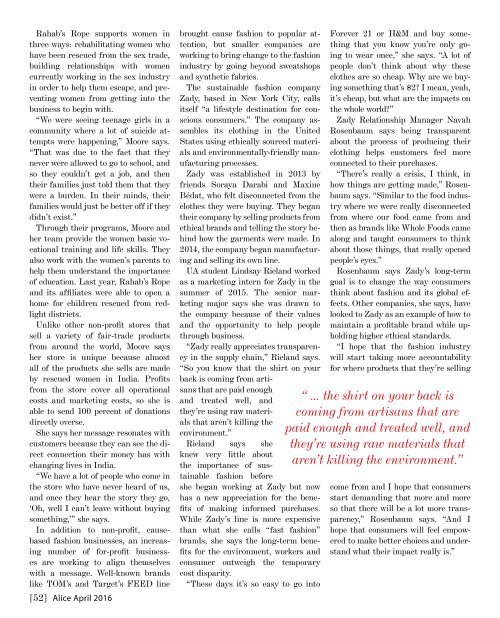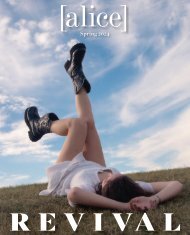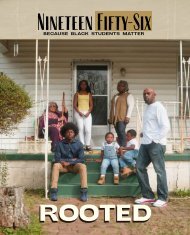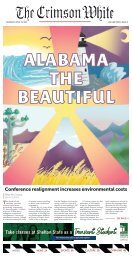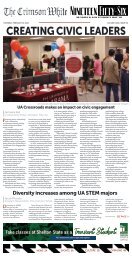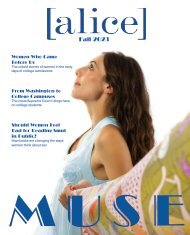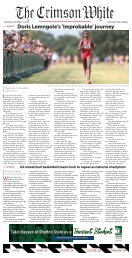Alice Vol. 1 No. 2
Published by UA Student Media April 2016.
Published by UA Student Media April 2016.
Create successful ePaper yourself
Turn your PDF publications into a flip-book with our unique Google optimized e-Paper software.
Rahab’s Rope supports women in<br />
three ways: rehabilitating women who<br />
have been rescued from the sex trade,<br />
building relationships with women<br />
currently working in the sex industry<br />
in order to help them escape, and preventing<br />
women from getting into the<br />
business to begin with.<br />
“We were seeing teenage girls in a<br />
community where a lot of suicide attempts<br />
were happening,” Moore says.<br />
“That was due to the fact that they<br />
never were allowed to go to school, and<br />
so they couldn’t get a job, and then<br />
their families just told them that they<br />
were a burden. In their minds, their<br />
families would just be better off if they<br />
didn’t exist.”<br />
Through their programs, Moore and<br />
her team provide the women basic vocational<br />
training and life skills. They<br />
also work with the women’s parents to<br />
help them understand the importance<br />
of education. Last year, Rahab’s Rope<br />
and its affiliates were able to open a<br />
home for children rescued from redlight<br />
districts.<br />
Unlike other non-profit stores that<br />
sell a variety of fair-trade products<br />
from around the world, Moore says<br />
her store is unique because almost<br />
all of the products she sells are made<br />
by rescued women in India. Profits<br />
from the store cover all operational<br />
costs and marketing costs, so she is<br />
able to send 100 percent of donations<br />
directly overse.<br />
She says her message resonates with<br />
customers because they can see the direct<br />
connection their money has with<br />
changing lives in India.<br />
“We have a lot of people who come in<br />
the store who have never heard of us,<br />
and once they hear the story they go,<br />
‘Oh, well I can’t leave without buying<br />
something,’” she says.<br />
In addition to non-profit, causebased<br />
fashion businesses, an increasing<br />
number of for-profit businesses<br />
are working to align themselves<br />
with a message. Well-known brands<br />
like TOM’s and Target’s FEED line<br />
[52] <strong>Alice</strong> April 2016<br />
brought cause fashion to popular attention,<br />
but smaller companies are<br />
working to bring change to the fashion<br />
industry by going beyond sweatshops<br />
and synthetic fabrics.<br />
The sustainable fashion company<br />
Zady, based in New York City, calls<br />
itself “a lifestyle destination for conscious<br />
consumers.” The company assembles<br />
its clothing in the United<br />
States using ethically sourced materials<br />
and environmentally-friendly manufacturing<br />
processes.<br />
Zady was established in 2013 by<br />
friends Soraya Darabi and Maxine<br />
Bédat, who felt disconnected from the<br />
clothes they were buying. They began<br />
their company by selling products from<br />
ethical brands and telling the story behind<br />
how the garments were made. In<br />
2014, the company began manufacturing<br />
and selling its own line.<br />
UA student Lindsay Rieland worked<br />
as a marketing intern for Zady in the<br />
summer of 2015. The senior marketing<br />
major says she was drawn to<br />
the company because of their values<br />
and the opportunity to help people<br />
through business.<br />
“Zady really appreciates transparency<br />
in the supply chain,” Rieland says.<br />
“So you know that the shirt on your<br />
back is coming from artisans<br />
that are paid enough<br />
and treated well, and<br />
they’re using raw materials<br />
that aren’t killing the<br />
environment.”<br />
Rieland says she<br />
knew very little about<br />
the importance of sustainable<br />
fashion before<br />
she began working at Zady but now<br />
has a new appreciation for the benefits<br />
of making informed purchases.<br />
While Zady’s line is more expensive<br />
than what she calls “fast fashion”<br />
brands, she says the long-term benefits<br />
for the environment, workers and<br />
consumer outweigh the temporary<br />
cost disparity.<br />
“These days it’s so easy to go into<br />
Forever 21 or H&M and buy something<br />
that you know you’re only going<br />
to wear once,” she says. “A lot of<br />
people don’t think about why these<br />
clothes are so cheap. Why are we buying<br />
something that’s $2? I mean, yeah,<br />
it’s cheap, but what are the impacts on<br />
the whole world?”<br />
Zady Relationship Manager Navah<br />
Rosenbaum says being transparent<br />
about the process of producing their<br />
clothing helps customers feel more<br />
connected to their purchases.<br />
“There’s really a crisis, I think, in<br />
how things are getting made,” Rosenbaum<br />
says. “Similar to the food industry<br />
where we were really disconnected<br />
from where our food came from and<br />
then as brands like Whole Foods came<br />
along and taught consumers to think<br />
about those things, that really opened<br />
people’s eyes.”<br />
Rosenbaum says Zady’s long-term<br />
goal is to change the way consumers<br />
think about fashion and its global effects.<br />
Other companies, she says, have<br />
looked to Zady as an example of how to<br />
maintain a profitable brand while upholding<br />
higher ethical standards.<br />
“I hope that the fashion industry<br />
will start taking more accountability<br />
for where products that they’re selling<br />
“ ... the shirt on your back is<br />
coming from artisans that are<br />
paid enough and treated well, and<br />
they’re using raw materials that<br />
aren’t killing the environment.”<br />
come from and I hope that consumers<br />
start demanding that more and more<br />
so that there will be a lot more transparency,”<br />
Rosenbaum says. “And I<br />
hope that consumers will feel empowered<br />
to make better choices and understand<br />
what their impact really is.”


